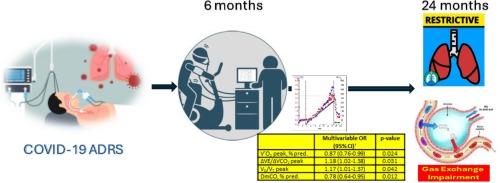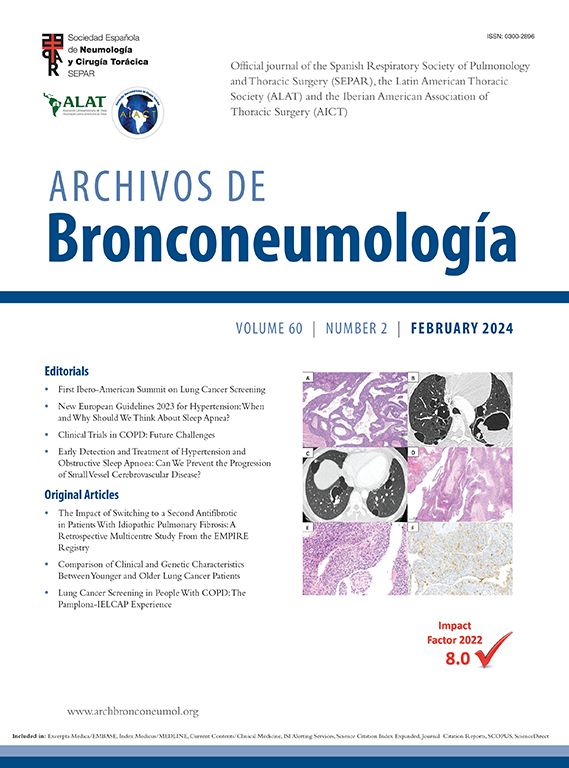Medium-Term Disability and Long-Term Functional Impairment Persistence in Survivors of Severe COVID-19 ARDS: Clinical and Physiological Insights
IF 8.7
3区 医学
Q1 RESPIRATORY SYSTEM
引用次数: 0
Abstract
Background
Although the medium- and long-term sequelae of survivor of acute respiratory distress syndrome (ARDS) of any cause have been documented, little is known about the way in which COVID-19-induced ARDS affects functional disability and exercise components. Our aims were to examine the medium-term disability in severe COVID-19-associated ARDS survivors, delineate pathophysiological changes contributing to their exercise intolerance, and explore its utility in predicting long-term functional impairment persistence.
Methods
We studied 108 consecutive subjects with severe COVID-19 ARDS who remained alive 6 months after intensive care unit (ICU) discharge. Lung morphology was assessed with chest non-contrast CT scans and CT angiography. Functional evaluation included spirometry, plethysmography, muscle strength, and diffusion capacity, with assessment of gas exchange components through diffusing capacity of nitric oxide. Disability was assessed through an incremental exercise test, and measurements were repeated 12 and 24 months later in patients with functional impairments.
Results
At 6 months after ICU discharge, a notable dissociation between morphological and clinical-functional sequelae was identified. Moderate-severe disability was present in 47% of patients and these subjects had greater limitation of ventilatory mechanics and gas exchange, as well as greater symptomatic perception during exercise and a probable associated cardiac limitation. Female sex, hypothyroidism, reduced membrane diffusion component, lower functional residual capacity, and high-attenuation lung volume were independently associated with the presence of moderate-severe functional disability, which in turn was related to higher frequency and greater intensity of dyspnea and worse quality of life. Out of the 71 patients with reduced lung volumes or diffusion capacity at 6 months post-ICU discharge, only 19 maintained a restrictive disorder associated with gas exchange impairment at 24 months post-discharge. In these patients, 6-month values for diffusion membrane component, maximal oxygen uptake, ventilatory equivalent for CO2, and dead space to tidal volume ratio were identified as independent risk factors for persistence of long-term functional sequelae.
Conclusions
Less than half of survivors of COVID-19 ARDS have moderate-severe disability in the medium term, identifying several risk factors. In turn, diffusion membrane component and exercise tolerance at 6-month ICU discharge are independently associated with the persistence of long-term functional sequelae.

严重 COVID-19 ARDS 存活者的中期残疾和长期功能障碍:临床和生理学见解。
背景:虽然任何原因引起的急性呼吸窘迫综合征(ARDS)幸存者的中长期后遗症都有记录,但人们对 COVID-19 引起的 ARDS 如何影响功能障碍和运动成分知之甚少。我们的目的是研究与 COVID-19 相关的严重 ARDS 存活者的中期残疾情况,明确导致其运动不耐受的病理生理学变化,并探索其在预测长期功能障碍持续性方面的效用:我们连续研究了 108 名重症监护病房(ICU)出院后 6 个月仍存活的重症 COVID-19 型 ARDS 患者。通过胸部非对比 CT 扫描和 CT 血管造影评估肺部形态。功能评估包括肺活量、胸透、肌力和弥散能力,并通过一氧化氮的弥散能力评估气体交换成分。通过增量运动测试评估残疾情况,并在 12 个月和 24 个月后对有功能障碍的患者进行重复测量:结果:重症监护室出院 6 个月后,发现形态学后遗症和临床功能后遗症之间存在明显差异。47%的患者存在中度-重度残疾,这些受试者的通气力学和气体交换受限程度更高,运动时的症状感更强,可能伴有心脏功能受限。女性性别、甲状腺机能减退、膜弥散成分减少、功能残余能力降低和高衰减肺活量与中度-重度功能障碍存在独立关联,而中度-重度功能障碍又与更高频率、更剧烈的呼吸困难和更差的生活质量有关。在重症监护室出院后 6 个月肺容量或弥散能力下降的 71 名患者中,只有 19 人在出院后 24 个月仍存在与气体交换障碍相关的限制性失调。在这些患者中,6个月的扩散膜成分、最大摄氧量、二氧化碳通气当量和死腔与潮气量比值被确定为长期功能性后遗症持续存在的独立风险因素:结论:不到一半的 COVID-19 ARDS 存活者在中期内会出现中度-重度残疾,这其中有几个风险因素。反过来,ICU 6 个月出院时的弥散膜成分和运动耐量与长期功能后遗症的持续存在有独立关联。
本文章由计算机程序翻译,如有差异,请以英文原文为准。
求助全文
约1分钟内获得全文
求助全文
来源期刊

Archivos De Bronconeumologia
Medicine-Pulmonary and Respiratory Medicine
CiteScore
3.50
自引率
17.50%
发文量
330
审稿时长
14 days
期刊介绍:
Archivos de Bronconeumologia is a scientific journal that specializes in publishing prospective original research articles focusing on various aspects of respiratory diseases, including epidemiology, pathophysiology, clinical practice, surgery, and basic investigation. Additionally, the journal features other types of articles such as reviews, editorials, special articles of interest to the society and editorial board, scientific letters, letters to the editor, and clinical images. Published monthly, the journal comprises 12 regular issues along with occasional supplements containing articles from different sections.
All manuscripts submitted to the journal undergo rigorous evaluation by the editors and are subjected to expert peer review. The editorial team, led by the Editor and/or an Associate Editor, manages the peer-review process. Archivos de Bronconeumologia is published monthly in English, facilitating broad dissemination of the latest research findings in the field.
 求助内容:
求助内容: 应助结果提醒方式:
应助结果提醒方式:


